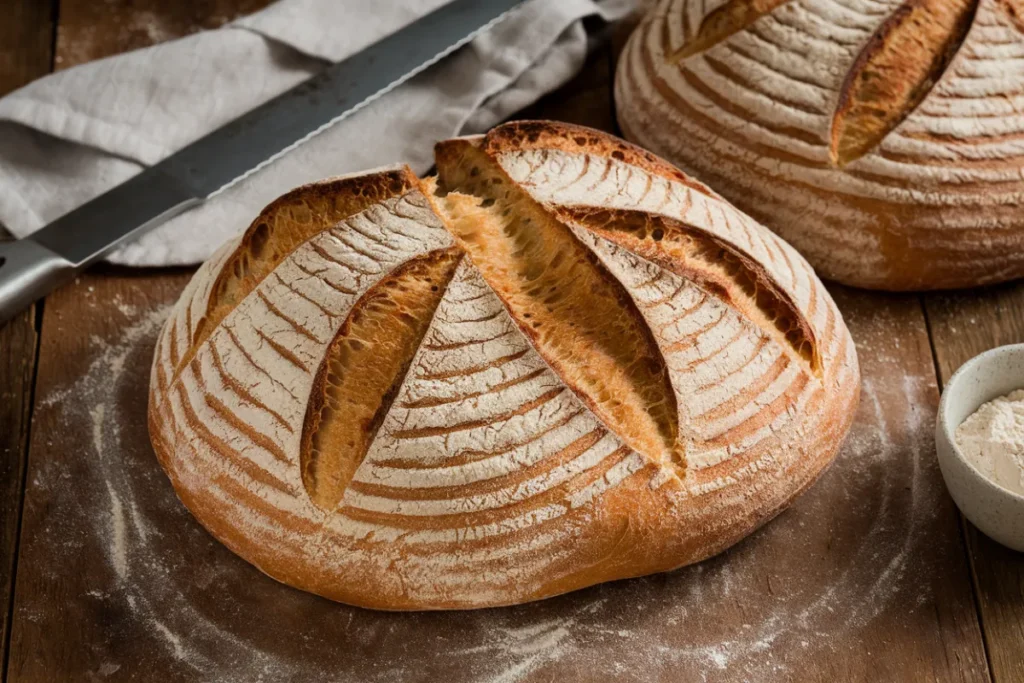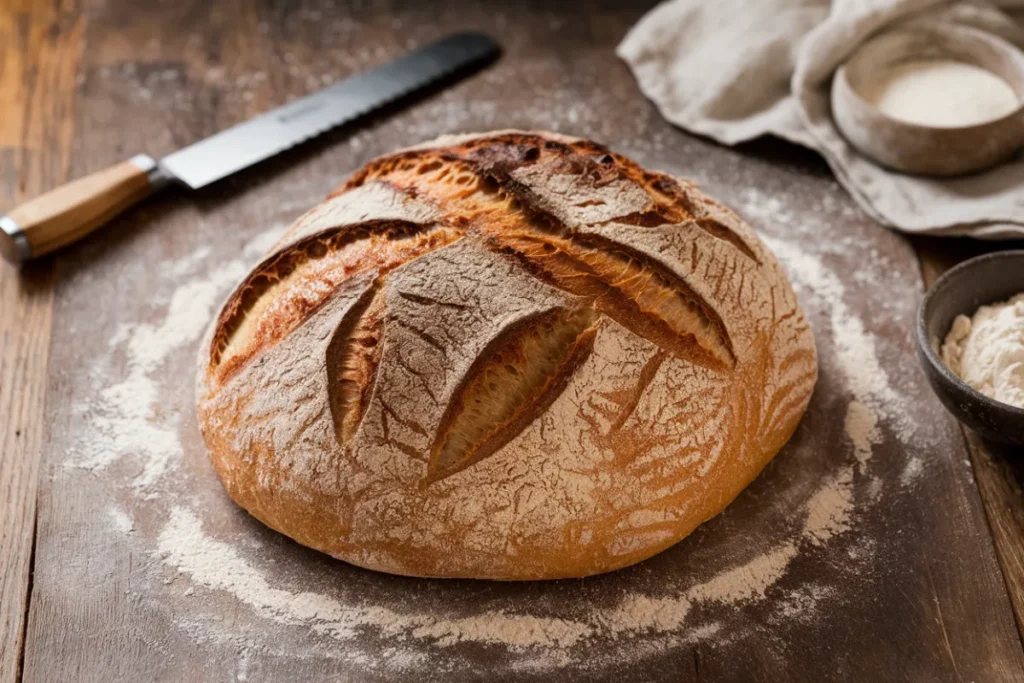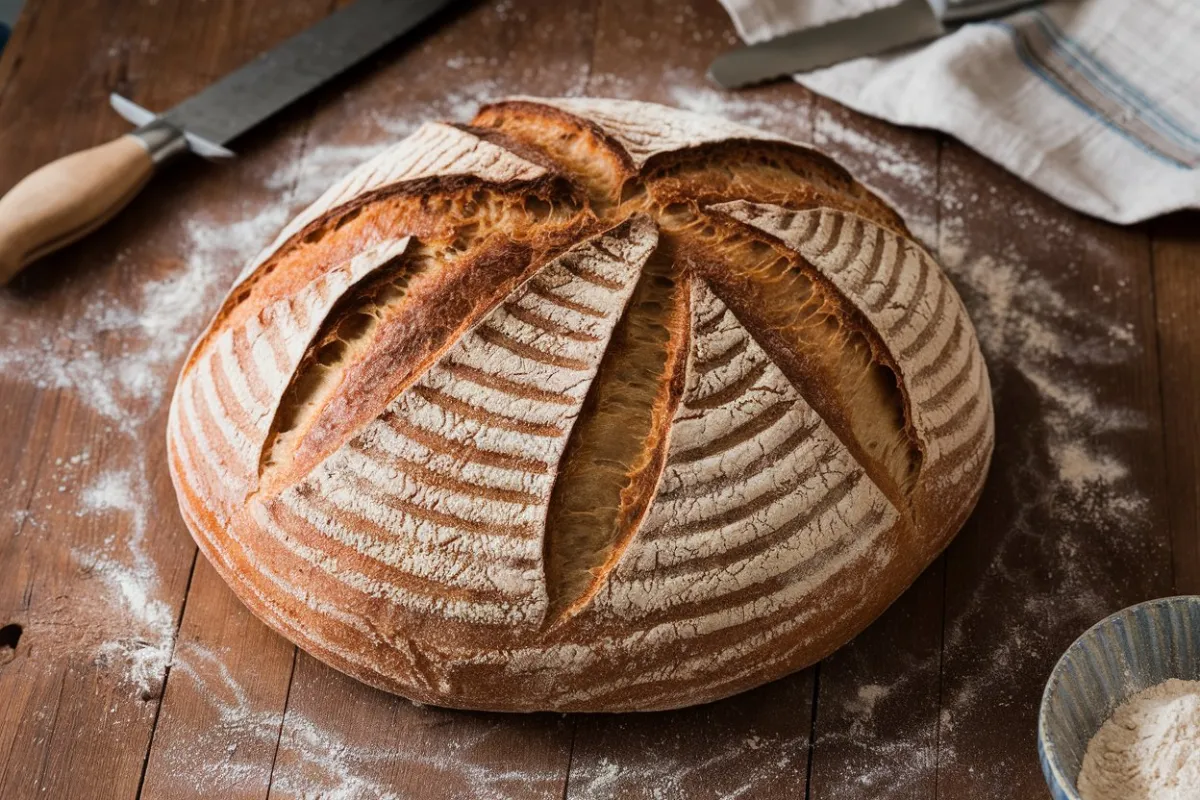In recent years, sourdough has become a favorite bread among food enthusiasts and casual eaters. But what drives this growing preference? Is it just a trend, or does sourdough offer something unique that differentiates it from other types of bread? This article delves into the various aspects that contribute to the popularity of sourdough, including its unique characteristics, health benefits, cultural significance, and more. By the end, you’ll understand why sourdough is more than just bread—it’s an experience.
Introduction to Sourdough
Sourdough is far from a new trend; it’s one of the oldest forms of leavened bread, dating back thousands of years. However, why do people prefer sourdough today? Its resurgence can be linked to its health benefits, rich flavor, and the artisanal craft that goes into its production. Unlike commercial bread, which uses added yeast for quick fermentation, sourdough undergoes a slow, natural fermentation process, leading to a more complex flavor and enhanced nutritional value.
The Unique Characteristics of Sourdough
What makes sourdough different from other types of bread? The answer lies in its natural fermentation process, which combines wild yeast and lactobacilli bacteria. This unique combination gives sourdough its distinctive tangy flavour and contributes to its chewy texture and crisp crust.
Natural Fermentation Process
The process of making sourdough is as much an art as it is a science. It begins with a sourdough starter, a mixture of flour and water that captures wild yeast and bacteria from the environment. Over time, this starter ferments, producing carbon dioxide that leavens the bread.
- Wild yeast: Unlike commercial yeast, explicitly cultivated for baking, wild yeast is naturally present in the air and flour. It’s less predictable but contributes to the unique flavour of sourdough.
- Lactobacilli bacteria: This beneficial bacteria produces lactic acid, which not only gives sourdough its tangy flavour but also helps preserve the bread, giving it a longer shelf life.
- Long fermentation: The extended fermentation process, often lasting several hours or even days, allows for more complex development of flavours. This starkly contrasts the rapid fermentation used in commercial bread production, which can result in a less flavorful product.
Flavor Profile and Texture
The flavour of sourdough is often described as tangy, but this is just one aspect of its complex profile. The exact taste can vary depending on factors such as the type of flour used, the environment where the bread is made, and the length of the fermentation process.
- Tangy flavour: The lactic acid produced by lactobacilli bacteria gives sourdough its characteristic tang. However, the level of sourness can vary, with some sourdoughs being only mildly tangy and others having a more pronounced sour flavour.
- Chewy texture: Sourdough’s crumb, or interior, is typically dense and chewy. This texture results from the long fermentation process, which allows the dough to develop strong gluten strands that trap air bubbles, giving the bread its chewy consistency.
- Crisp crust: One of the most beloved features of sourdough is its thick, crunchy crust. This crust forms due to the high baking temperatures used in sourdough production and adds a satisfying contrast to the chewy interior.
The Health Benefits of Sourdough
Beyond its unique flavour and texture, sourdough is also prized for its health benefits. The natural fermentation process enhances the bread’s flavour and makes it easier to digest and more nutritious than many other types of bread.
Improved Digestion
One of sourdough’s most significant health benefits is its positive impact on digestion. The long fermentation process breaks down many complex carbohydrates in wheat, making the bread easier to digest.
- Pre-digestion of gluten: The lactobacilli in sourdough help break down gluten, the protein in wheat that can cause digestive issues for some people. While sourdough is not gluten-free, reducing gluten content can make it more tolerable for those with mild gluten sensitivities.
- Lower FODMAPs: FODMAPs are a group of short-chain carbohydrates that can cause bloating and other digestive issues. The fermentation process reduces the levels of FODMAPs in sourdough, making it a better option for those with sensitive stomachs.
Lower Glycemic Index
The glycemic index (GI) measures how quickly a food raises blood sugar levels. Foods with a high GI can cause spikes in blood sugar, which can be problematic for people with diabetes or those trying to manage their weight.
- Slower digestion: The lactic acid in sourdough slows down the digestion of starches, resulting in a slower release of glucose into the bloodstream. This gives sourdough a lower GI compared to many other types of bread.
- Blood sugar regulation: Eating foods with a lower GI, like sourdough, can help regulate blood sugar levels, making it a good option for those looking to manage their blood sugar more effectively.
Nutritional Advantages
Sourdough also offers several nutritional benefits, thanks to the fermentation process.
- Increased mineral availability: The fermentation process breaks down phytic acid, a compound found in grains that can bind to minerals like iron and zinc and reduce their absorption. As a result, sourdough can provide more bioavailable nutrients than other types of bread.
- Rich in probiotics: The live bacteria present in sourdough can act as probiotics, promoting a healthy gut microbiome. This can lead to improved digestion and overall health.
The Artisan Appeal: Tradition and Craftsmanship
In a world filled with mass-produced foods, it’s clear why people prefer sourdough. Artisan sourdough stands out for its undeniable appeal, crafted through a slow, deliberate process deeply rooted in tradition, which only enhances its charm.

The Process of Making Sourdough
Unlike the quick and efficient methods used in commercial bread production, sourdough is a labour of love. It requires patience, skill, and a deep understanding of fermentation.
- Traditional methods: Sourdough has used the same basic methods for thousands of years. The process involves mixing flour and water to create a starter that is fed regularly to keep the wild yeast and bacteria alive. Once the starter is active, it’s mixed with more flour and water to create the dough, which is left to ferment for several hours before baking.
- Artisan craftsmanship: Many sourdough bakers take pride in their craft, using traditional techniques and high-quality ingredients to produce unique flavour and texture bread. This artisan approach adds to the appeal of sourdough, making it more than just a commodity but a work of art.
Cultural Significance
Sourdough is not just food; it’s a symbol of tradition and heritage. In many cultures, bread holds a special place as a staple food and the process of making it is often passed down through generations.
- Connection to the past: Baking sourdough is a way to connect with the past and engage in a practice that has sustained people for centuries. This connection to history adds a layer of meaning to the simple act of making and eating bread.
- Revival of home baking: The COVID-19 pandemic saw a resurgence in home baking, with many people turning to sourdough to pass the time and engage in a productive activity. This trend has continued, with sourdough becoming a popular hobby for those looking to reconnect with traditional food preparation methods.
Taste and Texture: Why Sourdough Stands Out
One of the key reasons why people prefer sourdough is its distinct taste and texture. These qualities distinguish it from other types of bread, making it a favorite among food enthusiasts.
Distinctive Tangy Flavor
The sourdough flavour is often described as tangy, but it’s also complex and nuanced, with subtle variations depending on the ingredients and the environment in which the bread is made.
- Lactic acid: The tangy taste of sourdough comes from the lactic acid produced during fermentation. This acid gives the bread its characteristic flavour and acts as a natural preservative, extending the bread’s shelf life.
- Flavour complexity: The long fermentation process allows for the developing of complex flavours that are hard to achieve in commercially produced bread. The result is a bread that’s rich, robust, and deeply satisfying.
Chewy Texture and Crisp Crust
The texture of sourdough is another critical factor in its appeal. Combining a chewy crumb and a crisp crust creates a delightful contrast that’s hard to resist.
- Dense, chewy crumb: The crumb of sourdough is typically denser and chewier than that of other breads. This texture results from the long fermentation process, allowing the gluten to fully develop and trap air bubbles, creating a strong and resilient structure.
- Thick, crunchy crust: The sourdough crust is thicker and crunchier than most other breads, thanks to the high baking temperatures used in sourdough production. This crust adds a satisfying crunch to every bite and helps protect the bread’s soft interior.
The Role of Social Media in Sourdough‘s Popularity
Social media has been a major factor in why people prefer sourdough, especially on platforms like Instagram, where home bakers and food influencers showcase their creations.
Influencer Endorsement and Viral Trends
The visibility of sourdough on social media has contributed to its popularity, with many people inspired to try making their bread after seeing beautiful photos and videos online.
- Instagram and food blogs: Sourdough has become a popular subject for Instagram posts and food blogs, with bakers sharing tips, recipes, and photos of their creations. This online community has helped demystify the sourdough process, making it more accessible to a broader audience.
- Viral challenges: Sourdough challenges, where bakers share their progress and results, have gone viral, encouraging more people to join in and try making their sourdough at home.
Community and Sharing
The sourdough community on social media is characterized by a spirit of sharing and collaboration, with bakers exchanging tips, troubleshooting advice, and encouragement.
- Online forums and groups: Besides Instagram, numerous online forums and Facebook groups are dedicated to sourdough baking. These communities allow novice and experienced bakers to connect, share knowledge, and celebrate their successes.
- Virtual workshops and tutorials: The popularity of sourdough has also led to the rise of virtual seminars and tutorials, where professional bakers share their expertise with a global audience. These resources have made it easier than ever for people to learn the art of sourdough baking.
The Environmental and Ethical Considerations
In today’s world, where sustainability and ethical eating are increasingly important, sourdough offers a way to enjoy bread that aligns with these values.
Sustainability of Sourdough Production
Sourdough’s production process is inherently more sustainable than many other types of bread, mainly when made using local, organic ingredients.
- Local and organic ingredients: Many sourdough bakers choose to use organic, non-GMO flour and other ingredients, supporting sustainable farming practices and reducing bread production’s environmental impact.
- Reduced waste: The longer shelf life of sourdough, thanks to its natural preservative properties, means less bread goes to waste. Additionally, using a sourdough starter reduces the need for commercial yeast, which can have a higher environmental impact.

Supporting Local Businesses
One reason why people prefer sourdough is that purchasing it from local bakeries, rather than opting for mass-produced bread from supermarkets, supports small businesses and boosts the local economy.
- Artisan bakeries: Many artisan bakeries specialize in sourdough, using traditional methods and high-quality ingredients to produce bread that’s not only delicious but also ethically made.
- Community support: By buying from local bakeries, consumers can help support their local community and ensure that these businesses continue to thrive.
The Versatility of Sourdough
Another reason why people prefer sourdough is its versatility. This bread can be used in various dishes, making it a staple in many kitchens.
Different Ways to Enjoy Sourdough
Sourdough is not just for sandwiches—there are countless ways to enjoy this versatile bread.
- Toast: Sourdough makes the perfect base for toast, whether topped with avocado, butter, or jam. The sturdy sourdough texture holds up well to toppings, making it a popular choice for breakfast.
- Sandwiches: The dense crumb and thick crust of sourdough make it ideal for sandwiches, especially those with hearty fillings like meats, cheeses, and vegetables.
- Bread bowls: Sourdough is often used to make bread bowls for soups and stews, thanks to its sturdy structure that can hold up to hot, liquid fillings.
- Global variations: Sourdough has variations worldwide, from French pain au levain to Italian pane toscano, each with its unique flavour and texture.
Cooking and Baking with Sourdough
Sourdough is also a versatile ingredient in cooking and baking, adding depth of flavour and texture to various dishes.
- Sourdough pancakes and waffles: Using sourdough starter in pancake or waffle batter adds a tangy flavour and a light, airy texture to these breakfast favourites.
- Sourdough pizza crust: The chewy texture and complex sourdough flavour make it an excellent base for pizza crust, adding an extra dimension to this beloved dish.
- Sourdough stuffing: Sourdough bread is often used in stuffing, where its dense crumb soaks up flavours without becoming soggy.
Common Misconceptions About Sourdough
Despite why people prefer sourdough, there are still some aspects of it that need to be clarified.
Is Sourdough Difficult to Make?
One common misconception is that sourdough is challenging to make. While it does require time and patience, the process is more straightforward than it might seem.
- Myth: Many people believe sourdough is hard to make because it requires a starter and a long fermentation process.
- Reality: With the proper guidance and a little practice, anyone can make sourdough at home. The process may be time-consuming, but it’s also rewarding and worth the effort.
Is Sourdough Always Sour?
Another misconception is that all sourdough is sour. While the name might suggest that the flavour of dough can vary widely,
- Many people assume that all sourdough has a strong, sour flavour.
- Reality: The level of sourness in sourdough can be controlled by adjusting the fermentation time and the type of flour used. Some sourdoughs are mildly tangy, while others have a more pronounced sour flavour.
Is Sourdough Just a Trend?
Finally, some people dismiss sourdough as a passing trend popularized by social media and the pandemic.
- Myth: Sourdough’s current popularity is just a fad, driven by the COVID-19 pandemic and social media influencers.
- Reality: Sourdough has existed for thousands of years and is likely to remain popular due to its unique qualities, health benefits, and cultural significance. While the pandemic may have sparked a renewed interest in home baking, sourdough’s appeal goes far beyond a passing trend.
Conclusion: The Enduring Popularity of Sourdough
In conclusion, the reasons why people prefer sourdough are as varied as the bread itself. From its health benefits to its complex flavour, deep roots in tradition, and social media popularity, sourdough has become a beloved staple in many households. Its popularity will continue as more people discover the joys of making and eating sourdough. Whether you’re drawn to its rich, tangy flavour, its nutritional benefits, or the satisfaction of baking it yourself, sourdough is a bread that offers something for everyone.
Frequently Asked Questions
Is sourdough healthier than regular bread?
Yes, sourdough is often considered healthier due to its natural fermentation process, which can improve digestion and regulate blood sugar levels.
Can I eat sourdough if I’m gluten-sensitive?
Many people with mild gluten sensitivity can tolerate sourdough better than other breads because the fermentation process breaks down some gluten.
Why does sourdough taste sour?
The tangy taste of sourdough comes from lactic acid, produced by the lactobacilli bacteria during fermentation.
How long does sourdough bread last?
Sourdough can last several days if stored properly. Keeping it in a bread box or wrapping it in a cloth can help maintain its freshness.
Can I make sourdough at home quickly?
While sourdough does require time and patience, it’s easy to make with the right tools and guidance. Many people find the process rewarding and worth the effort.

